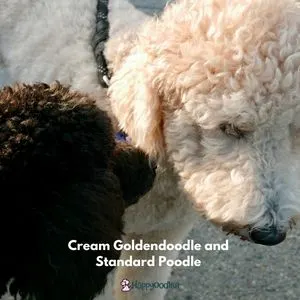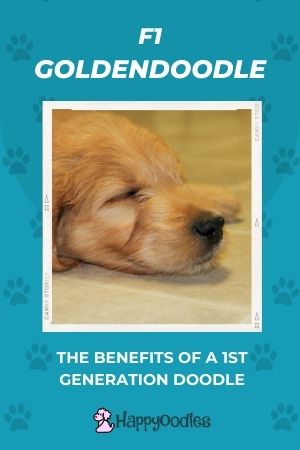If you are looking to get a Goldendoodle you may have heard about the doodle classifications; F1 Goldendoodle, F1b Goldendoodle, F2 Goldendoodle, F2B Goldendoodle and the F3 Goldendoodle also known as a multi-generation Goldendoodle.
You may also be wondering what this all means. In this post we will look at what it means to be an F1 Goldendoodle, how it compares to the other types of Goldendoodles and why the F1 might be the best choice for some people but not for others.
Let’s start with what the doodle classifications are. They are an easy way to tell the approximate percentage of Poodle vs Golden Retriever in the pups. We will explain why this matters in more detail below.
Another option you have to decide on when getting a Goldendoodle is the size. Goldendoodles come in a few different sizes. The two most popular Goldendoodle sizes are the standard and mini. But there is also a micro mini, teacup sizes and the unofficial medium size.
When looking for a Goldendoodle people often want to know which doodle is the best one to pick. But there is no one best option for all. It will depend on what your wants and needs are.

Goldendoodle Basics
A Goldendoodle is a cross between a Golden Retriever and a Poodle. Goldendoodles come in a few different sizes; standard, mini, and micro mini. Although not widely advertised you can also get a small standard or medium Goldendoodle.
Goldendoodle sizes
It’s a common belief that the size of a Goldendoodle is solely determined by the size of the poodle used in the breeding. That is not completely accurate. Although a mini poodle is used in breeding a mini Goldendoodle, a responsible breeder will pare dogs closer in size so the offspring will be more predictable in both size and structure.
In the case of the F1 mini Golden doodle a smaller Golden Retriever should be used when breeding to a larger mini poodle. In some cases they may choose to use a Moyen Poodle (medium sized poodle) with a small Golden to create a small standard or large mini Goldendoodle. These pups fall will in the medium size range for dogs.
Goldendoodle Size Chart

Goldendoodle Generation Classifications
To get the desired look and temperament most people want in a Goldendoodle, breeders have experimented with crossing different generations of Goldendoodles.
To help people understand which type of cross they are getting, a set of codes was established that most breeders go by. These codes are F1, F1b, F2, F2b, F3 or multi-generation.
For today’s post we will be focusing on the F1 Golden doodle and how it compares to the F1b Goldendoodle.
What is a F1 Goldendoodle
The F in F1 states for filial. In biology, filial denotes the generation or generations after the parental generation. So an F1 Goldendoodle is a first generation mating between a Poodle and a Golden Retriever.
This means that a F1 doodle will get half of their genes from the poodle and half from the Golden Retriever. This is very important because these genes will determine the temperament, looks and health of the puppies.
Canine Genetics Overview
The below explanation of Canine Genetics is from the UK Kennel Clubs article; Understanding canine genetics.
A gene is a section of DNA that has specific instructions for making a particular molecule, usually a protein. All dogs have two copies of every gene, one of which is inherited from its mother and one from its father. These two genes may be the same or they may be slightly different. These different versions of the same gene are called alleles.
Alleles can be either recessive or dominant. A recessive allele is only expressed (influences the characteristics of the dog) if both alleles are the same. A dominant allele on the other hand is always expressed, even if it is accompanied by a different allele.
Differing genes contribute to each dog’s unique physical features and account for the differences between each dog and each breed.
UK Kennel Clubs article; Understanding canine genetics.
So to recap a Goldendoodle gets half its genes from the Golden Retriever and half from the poodle. These genes control all the physical aspects of the dog’s looks. Like if their hair is straight or curly or if they will have long or short hair on their face. Some of the genes are dominant like the gene that give the doodle the teddy bear look.

A Dog’s Genes Influence their Personality
It has been determined that a dog’s genes not only determine their physical characteristics but also a large part of their temperament. The rest of their temperament is determined by their upbringing.
In an experiment by Jasper Rine of Berkeley, as part of the Dog Genome Project, Rine set out to see how temperaments of two very different dogs would be passed down.
In the experiment he crossbred a Border Collie with a New Foundland to see which of the two very different temperaments would be passed down to the puppies.
The finding from the initial cross showed that the puppies inherited a blend of traits from both breeds.
What does all this mean for the Goldendoodle?
You may be wondering what all this has to do with the F1 Goldendoodle. Just like in the experiment above the puppies of a F1 litter will inherit a mix of genes from both parents.
Some of the F1 puppies will have straight hair, while others will have a curlier coat and more still will come out in the middle with the desired wavy coat.
The same thing goes with an F1’s Goldendoodle’s temperament. They may follow the Golden or the Poodle but most will have some combination of the two personalities.
Since the Golden and Poodle were both sporting dogs at one time they already have a lot of the same personality traits. Things like running and playing fetch comes naturally to them both. They are also both considered to be highly intelligent.
Where their personalities really differ is when it comes to strangers. Goldens have never met a stranger but poodles tend to be more reserved when it comes to new people.
But remember although they inherit much of their personalities from the parents there is still room to change it. This can be done with proper socialization and puppy training.
The same thing can happen in reverse. A friendly golden retriever pup will grow to be standoffish and non trusting if they are bred under poor conditions. Even more so if they have been mistreated since birth.
This is why it’s very important to know who you are getting your puppy from. Only buy from a breeder that takes the time to talk with you. They should be screening you to make sure their puppies are going to safe homes.
Breeders who need brokers or middlemen to sell their puppies, probably do not take care of the puppies very well.

F1 Goldendoodle vs the F1B Goldendoodle
As we already stated the F1 is a first generation cross of a Golden and Poodle. The b in F1b stands for cross back. Meaning they crossed the F1 with one of the two pure-breeds. In the case of the F1b Goldendoodle, an F1 Goldendoodle is mated to either a Poodle or Golden.
A poodle is typically used for the cross back since breeders are looking to pass down two non-shedding genes, but sometimes a Golden is used if the breeding dog inherited too many poodle traits, like a very curly coat.
The main differences between the F1 and the F1b is that the F1b may have a curlier coat, if a poodle was used in the cross-back. The Goldendoodle may also shed less and they may have inherited more of the poodle’s personality.
On the other hand the F1 will maintain more of the Goldendoodles friendly personality, but will shed more.
Because the F1B sheds less they are generally considered the better option for families with allergies.
Genes can also affect the Goldendoodle lifespan, to learn more check out our post on How long do Goldendoodles live

Pros and Cons to Getting a F1 Goldendoodle
Benefits of getting a F1 Golden doodle
So we already talked about some of the benefits of an F1 Golden doodle. But just in case you missed them here they are again. Plus more reasons a F1 might be a better choice.
- Personality – The F1 retains more of the easy going, friendly personality of the Golden than later generation doodles.
- The F1 will shed less than a Golden Retriever. If you really love the Golden Retriever’s looks and personality but want a break from the heavy shedding, than an F1 might be right for you. Especially since it can retain a lot of the Golden charm without as much fur on the ground.
- If you don’t like the look of the poodle’s curly coat, it is easier to find an F1 with a straight to wavy coat. Just make sure to let your breeder know this up front. An experienced breeder should be able to guide you to the right pup.
- Less maintenance. A curlier coat means more maintenance to keep it mat free. F1 golden doodles with a straight coat will mean less grooming time and expenses.
- Less expensive. Multi-generation Goldendoodles that have genetic health tested parents can cost $5,000 or more. On the other hand a health tested first generation Goldendoodle can be found for $3,000 to $4,000.
- Some of the allure of having a cross bred is not knowing what you are getting. If you are the type of person that likes surprises, an F1 might be the perfect choice.
Reasons you shouldn’t get a F1 Doodle
Most of the benefits listed above can also be negatives for some people.
- Less predictability
- More shedding means they are going to be less hypoallergenic
- Many do not have the desired teddy bear look.

Do F1 Goldendoodles Shed?
An F1 Goldendoodle will shed more than a purebred poodle but it will be less than a purebred Golden Retriever.
The reason they shed is that the poodle will pass down one low shedding gene and the golden will pass one shedding gene, but neither gene is dominant. Instead the two genes seem to work together to cause less shedding.
You may have heard people say that their F1 Golden doodle doesn’t shed.
This can happen for one of two reasons. First, if they regularly brush and line comb their doodles, they are pulling out the loose hair that would normally fall on the floor.
The other reason is that they do not brush their doodle regularly and the loose hair is caught in their curly coat. This will eventually form mats in their fur.
Either way the loose hair never makes it to the floor in enough quantity to look like they are shedding.
Are F1 Golden doodles Hypoallergenic?
There are no guaranteed allergy free dogs. It’s believed that people are allergic to a protein that is found in a dog’s skin cells, saliva and urine. So even hairless dogs can cause an allergic reaction in some people.
The reason poodles and by default doodles are considered hypoallergenic is because they shed less than other types of dogs.
For some people with pet allergies, their allergies are triggered when they are exposed to a dog’s skin cells (also known as dander) that are released into the air when a dog sheds.
So the theory goes that if a dog does not shed or sheds minimally there is less dander (skin cells) to be exposed to thus making them a better option than most dogs.
Just remember that shedding is only one of the ways people come in contact with the protein that causes allergic reactions. Being licked by a dog, petting them, brushing them or cleaning up after them are just some of the ways you can be exposed to the protein.
It’s always best to spend time with the dog or the parents to see if you will have an allergic reaction before you commit to a dog.

Where to find a F1 Golden doodle
You will want to find a reputable breeder that will work with you to make sure you get what you are looking for. A good place to start your search is at the Goldendoodle Association of North America (GANA). GANA has a ribbon certification for breeders that follow strict breeding standards. You can find a list of breeders with their ribbon status on the GANA site.
When looking at breeders you will find that there is a wide range in Goldendoodle costs. Breeders that conduct health testing and carefully breed their dogs will cost more than ones that don’t.
Another option is to adopt an F1 Golden doodle. There tends to be more F1 doodles available for adoption than any of the other generation due to the increased chance of shedding. Here is a list of Goldendoodle rescue organizations to explore.
